Adaptive Equipment 101 (for Non-Ambulatory Children)
Equipment overload!! If your child is not able to walk, chances are that his/her physical therapist has suggested, or even tried, a variety adaptive equipment. There are so many types of adaptive equipment and at times it can really feel like your home has been invaded by all of them. So what is each piece of equipment for and what does it look like?
1. Adaptive Activity Chair
Activity Chairs are used for children who may have inadequate head or trunk control, are unable to sit up on their own or cannot sit in a regular chair for a variety of other reasons.
They can be customized with headrests, lateral trunk supports, footrests, and have features such as the ability to recline or tilt-in-space. They can be used for school-related activities, feeding, or play and often have a removable tray. Generally the wheels are smaller so they are easier to maneuver around the house, too. We have only had the experience of using different versions of the Rifton Activity Chair. The Rifton chair is also height adjustable with just a touch of the foot pedal (even while the child is in the chair) so you can use it at different heights (i.e. if you want your child to be sitting a level a toddler would sit at to interact with siblings or peers you can lower the child but if you want him/her to sit at the dinner table height you can raise it) . This is our primary chair for use inside the house. We have been very pleased with the Rifton chair (pictured below) and have no intention of looking for a different version . I’ve decided that if something is not broken, I’m not going to try to fix it because there are a million other things about my child that can use the attention instead.
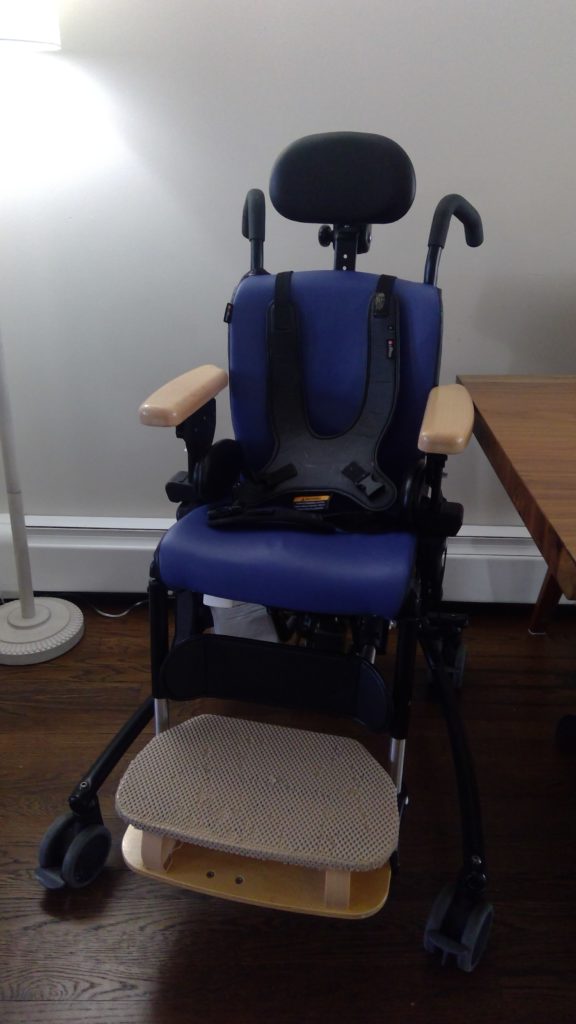
2. Standers
Standers promote upright positioning and sustained weight-bearing.
Typical children learn to stand and walk at a young age which naturally results in weight-bearing. Weight-bearing stimulates bone development, making bones stronger and lessens the risk of bone fractures. Standers can also help with trunk control and strengthening leg muscles depending on the type and amount of support provided. For a child who is unable to stand on his/her own, being upright can also help with gastrointestinal issues (I use ours to treat our son’s constipation all the time since gravity works miracles!) and even breathing (think about lung expansion in a child who is barely mobile). Standers allow the child to experience what it feels like to be upright and interact with their peers and environment which can be a whole new world for them. Our son goes to music class in his elementary school and really enjoys being upright with his classmates which great for him socially.
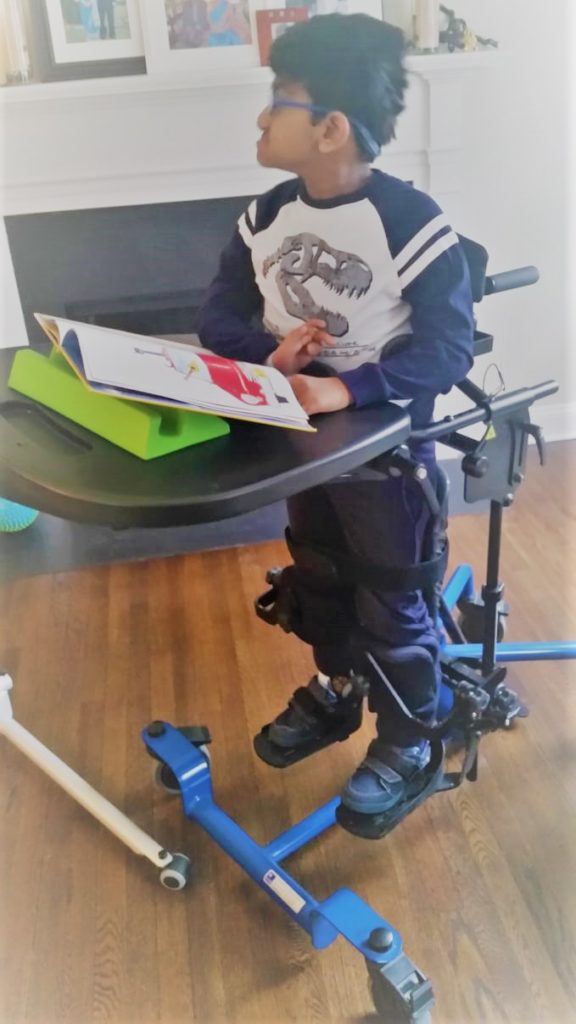
Two common types of standers are prone standers and supine standers and I’ll give you a very basic description of each. Prone standers have most of the support on the child’s stomach side and supine standers have most of the support on the child’s back side. The type of stander your child needs depends on a variety of factors including their tone, flexibility, and purpose for which it is being used just to name a few. Your physical therapist is the best person to help determine which type is best for your child.
The stander you see above is the Easy Stand by Bantam (a supine stander). I love this stander because you initially place the child in the stander in a sitting position and there is a hydraulic lift that works by pressing one foot on a pedal and one hand on handle in the back. In one motion your child can go from sitting to standing with no strain on you! This is ideal for children who are heavier (I think our son was about 60lbs when we received this one, which was just enough weight for us to make a different in the ease of carrying him). He uses it at home for activities such as coloring or playing his i-pad and at school for art class or interaction with his peers (the school purchased their own).
Here is another example of a supine stander https://www.schoolspecialty.com/supine-positioning-1327578?msclkid=2b9c6108537c1287ac0b3d536ffbe1a4&utm_source=bing&utm_medium=cpc&utm_campaign=(ROI)%20Shopping%20-%20Special%20Needs&utm_term=4579534650704343&utm_content=Special%20Needs
We have tried prone standers in the past but have not used one consistently enough for me to give you a recommendation but here is a link just for an example: https://www.rifton.com/products/standers/prone-standers .
3. Gait Trainers
A gait trainer is exactly that, something to train your child to have gait (the ability to move one’s legs to walk). You may also hear it referred to as a “walker”.
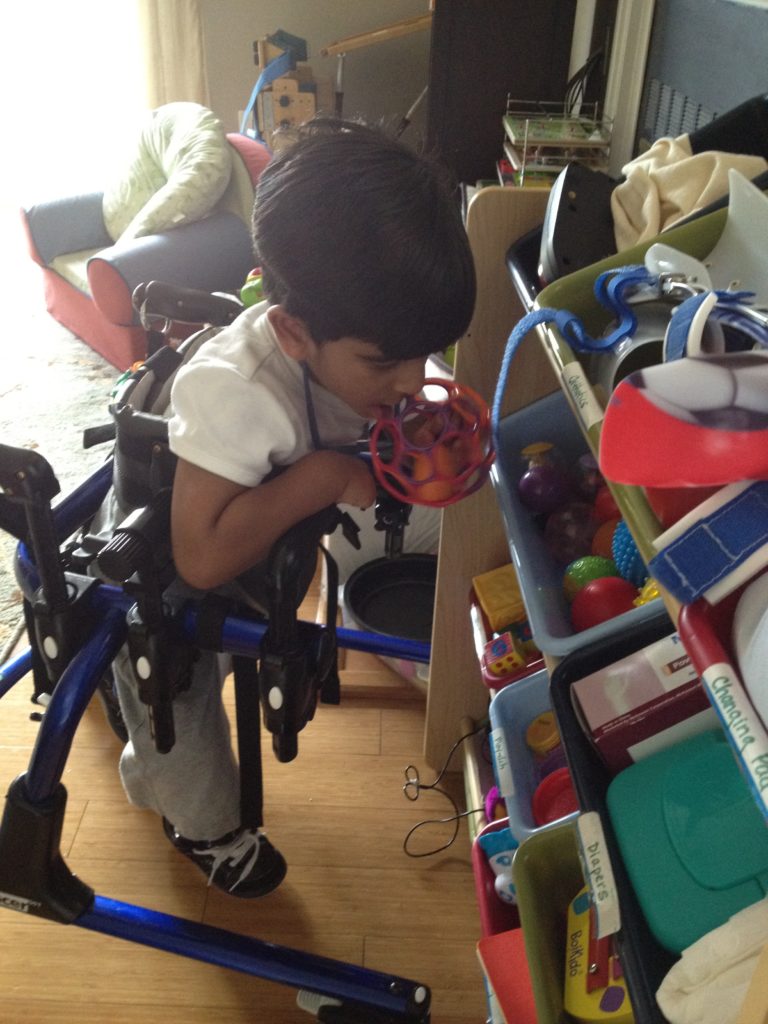
There is a base with wheels so that the child can freely move their legs in a walking motion while supporting their upper body by holding the frame. For those who need it there are options for a seat and trunk support (pictured above and below), giving them full support while they learn to move their legs. There are many schools of thought about whether a child who has not gone through the physical developmental stage of sitting or crawling should be trained to walk. In my experience and speaking with different physical therapists over the years, I have learned that there may be other benefits of using a gait trainer in additional to actual “gait training”. Gait trainers, like standers, can give a child the opportunity to interact with the environment and peers. If they are able to independently move the gait trainer it can also be a confidence-booster. It can also improve their awareness of their body and how it moves in space, which is often difficult for some children. Again, your child’s physical therapist can assess whether this piece of equipment is appropriatefor your child.
Below are pictures of two examples of gait trainers our son has used. The first one is a Rifton gait trainer and the second gait trainer (in red) is a Kidwalk by Prime Engineering. The Kidwalk has a bicycle-like seat that moves from side to side which allows for easier weight shifting (a natural movement that occurs during normal gait). The Kidwalk has been my favorite for this reason. I also like that our son could walk right up to a table and play as compared to the Rifton in which the arm supports would get in the way. I’m not sure if the Kidwalk has an arm support option for those require it so that may be something to ask about.
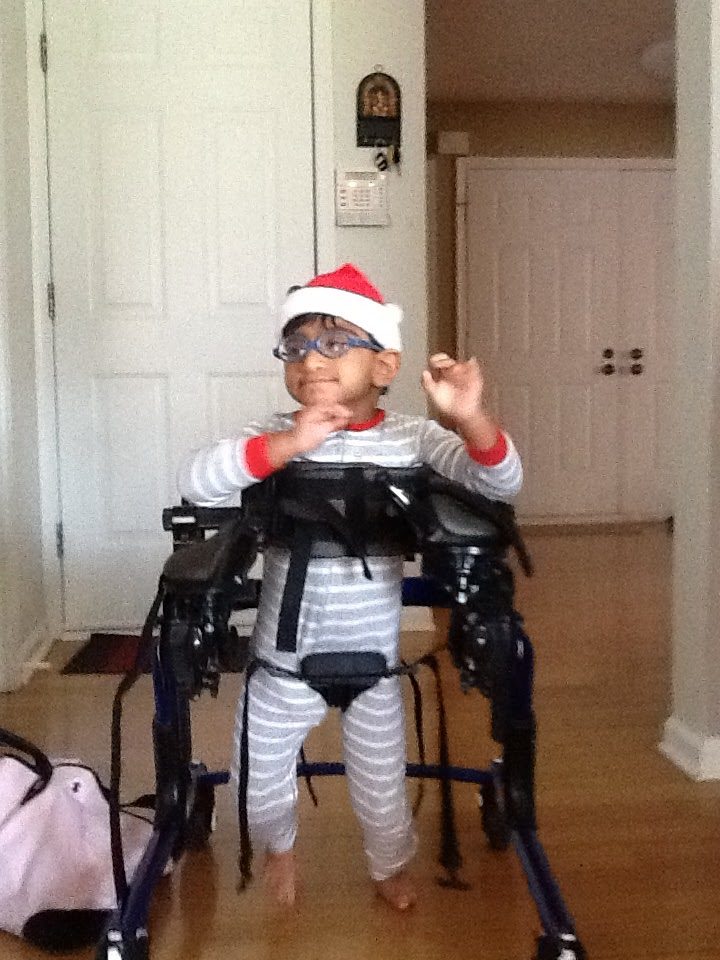
Rifton Gait Trainer with Trunk and Arm supports (These can be removed or ordered without them for a child who needs less support)
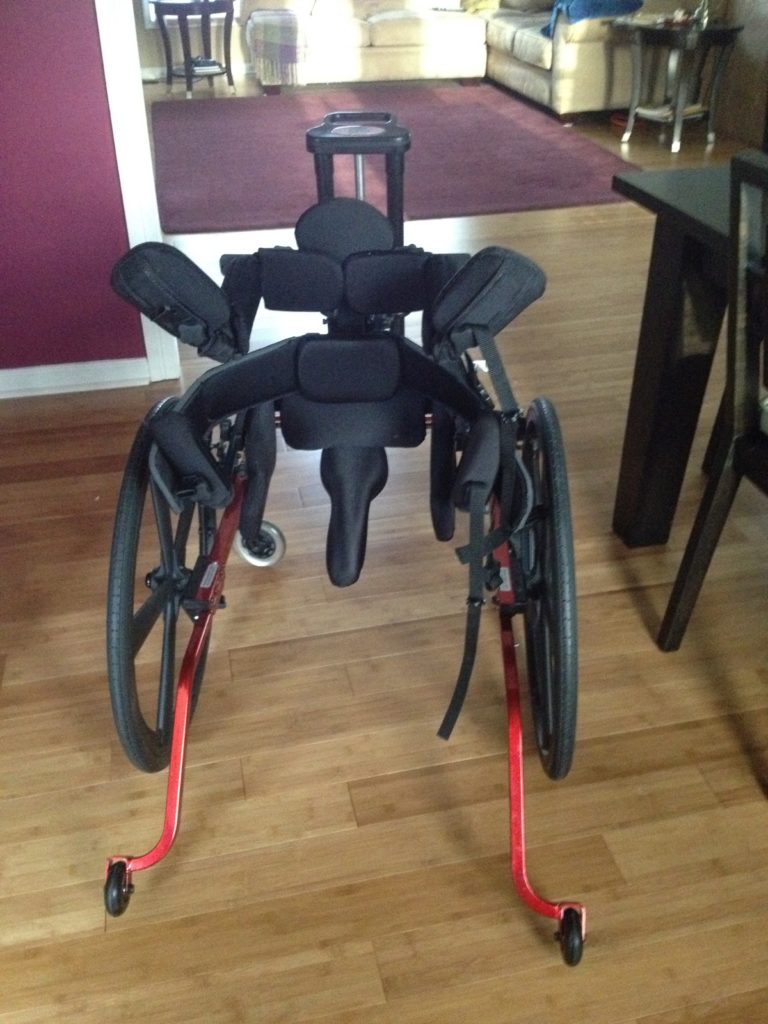
4. Bathing Chair
An adaptive bathing chair can either be seating for a bathtub (one example pictured above) or a shower chair (see example below). For a child who needs head and trunk support, usually the best option is a chair that is partially reclined. We have used the Leckey Bath Chair (displayed below) and the Rifton version (not pictured here) and I felt both were comparable. The Leckey seems a little longer to allow full support of the legs if that is a priority for you. Both have adjustable legs that can be positioned to allow the bath chair to sit low in the tub for a true bath experience. For a smaller child this may not be difficult, but as a child becomes heavier, lifting him/her can be more challenging so we eventually raised the chair as seen above. At some point when the child is even heavier, families may opt to modify their bathrooms to create a roll-in shower. A roll-in shower can accommodate a rolling bath chair or a shower chair. Some bath chairs can be placed on a rolling base which can then be rolled into an accessible shower (stay tuned for future posts on accessible showers). This is great because you get the comfort of a reclined seat but the convenience of rolling it into and out of the shower.
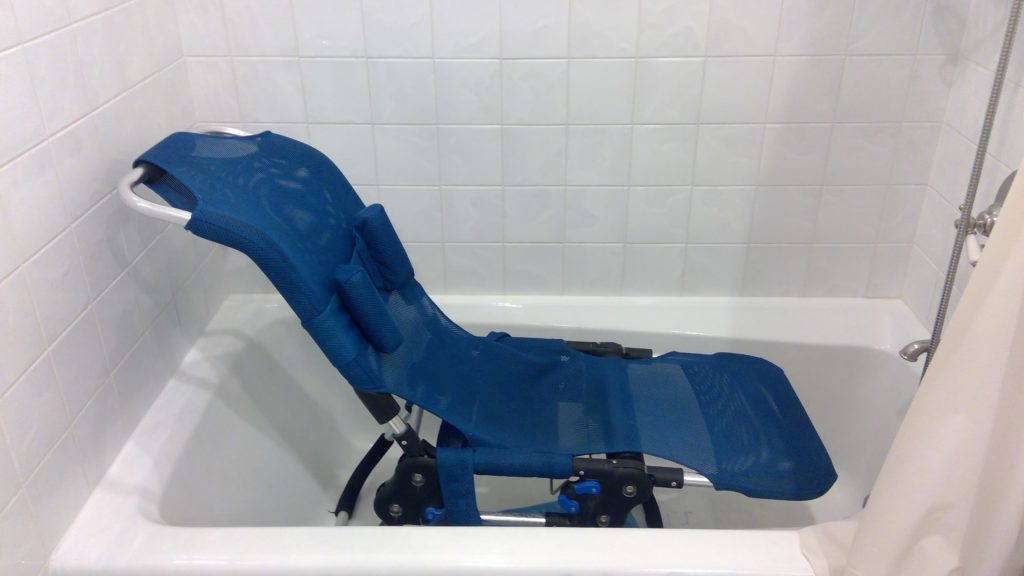
We used the Rifton HTS Showering/Toileting system (pics below) which allowed our son to use the toilet and then be rolled into the shower once we had an accessible shower (minimizing transfers). We also ended up purchasing a portable base for the Rifton HTS (although insurance did not cover this) that can be used with the seat portion of this chair to use when traveling to visit family. The base does not have wheels but it packs up like a suitcase and was a lifesaver! There are many brands of bathing/showering systems so ask your therapist or equipment vendor what is available to order and their recommendations.
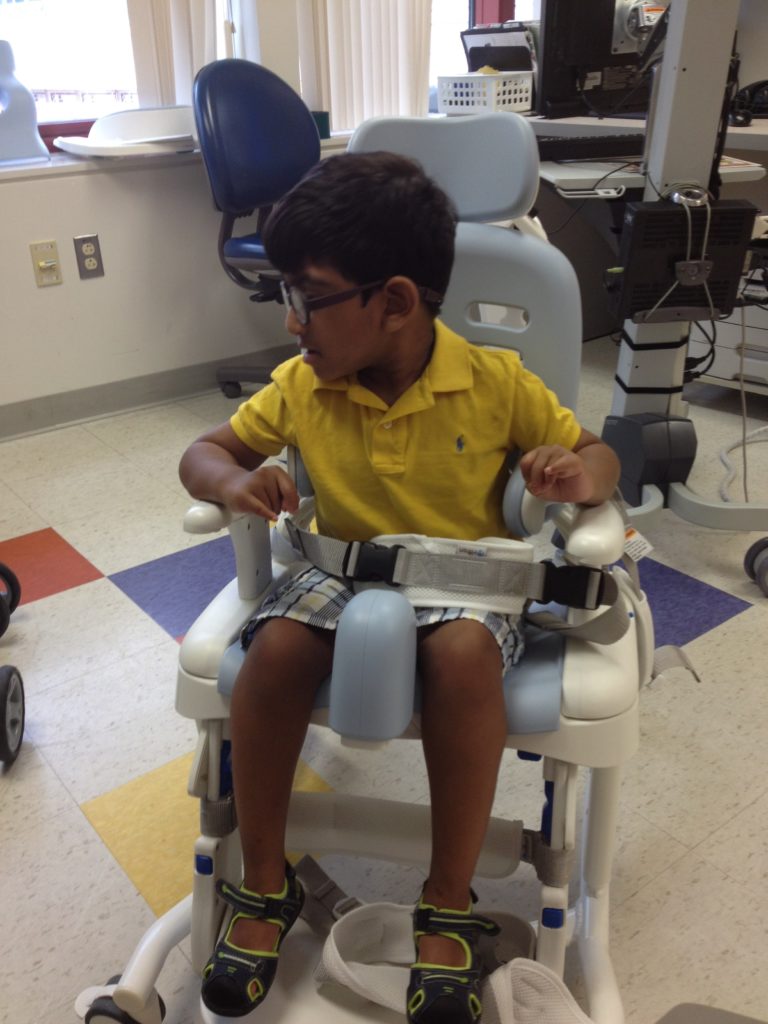
I hope this has given you a basic overview of some common pieces of equipment for children with physical impairments. I am fully disclosing that I am no expert, just a mom reporting and sharing from experience (although I am a medical provider by profession physical therapist by degree). Please feel free to leave comments or ask specific questions about any of the equipment above. If you are not aware, there is an event called the Abilities Expo where different vendors come together in one place. It’s a one-stop shop for various different equipment and services and many times you can try pieces of equipment with your child. They even have accessible vans there!! We try to go the the NY metro Abilities Expo which is located in northern NJ every year and have found it to be very useful, especially if we are searching for a new piece of equipment. This is how we found the stander above and how we decided which type of accessible van to purchase. Check it out if you can!
P.S. For wheelchairs/adaptive strollers see :
